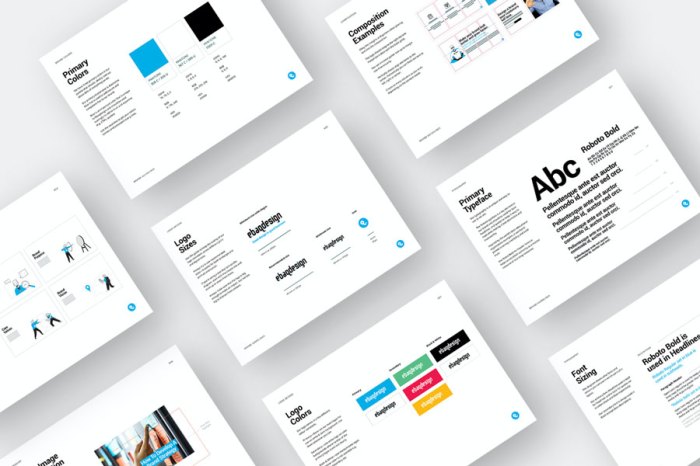Building a Marketing Style Guide sets the foundation for a strong brand identity, ensuring consistency and professionalism across all marketing platforms. Dive into the key components and processes to create a guide that resonates with your target audience and reflects your unique brand voice.
Importance of Marketing Style Guide

Having a marketing style guide is crucial for maintaining a consistent brand identity. It ensures that all marketing materials reflect the same look, tone, and feel, helping to establish brand recognition and loyalty among customers.
Maintaining Brand Identity
A style guide can help maintain a cohesive brand identity across different marketing channels by providing guidelines on logo usage, color schemes, typography, and tone of voice. This consistency reinforces brand recognition and trust among consumers.
Ensuring Clarity and Professionalism
The role of a style guide in marketing communications is to ensure clarity, professionalism, and uniformity in all messaging. By defining rules for grammar, punctuation, and formatting, a style guide helps to present a polished and professional image to the audience.
Components of a Marketing Style Guide: Building A Marketing Style Guide

Creating a comprehensive marketing style guide involves including key elements that help maintain consistency and coherence in all marketing materials. These elements typically cover various aspects of branding, messaging, and visual identity that reflect the organization’s unique personality and values.
Brand Voice and Tone, Building a Marketing Style Guide
- Define the brand’s voice: Describe the personality and characteristics that should come across in all communication.
- Establish tone guidelines: Specify how the brand should sound in different situations, whether formal, casual, or playful.
- Provide examples: Include sample phrases or sentences to illustrate the desired voice and tone.
Visual Guidelines
- Logo Usage: Detail how and where the logo should be used, including size, placement, and color variations.
- Color Palette: Specify the primary and secondary colors that represent the brand and their proper usage.
- Typography: Artikel the fonts to be used in various materials, ensuring consistency in text styles.
- Imagery Guidelines: Define the types of images that align with the brand aesthetic and message.
Content Guidelines
- Messaging Strategy: Provide guidance on the key messages to convey and how to articulate them effectively.
- Writing Style: Establish rules for grammar, punctuation, and formatting to maintain a cohesive writing style.
- Content Types: Specify guidelines for different types of content, such as social media posts, blog articles, or press releases.
Tailoring the Style Guide
To tailor a style guide to fit the specific needs of a business or organization, consider factors such as industry, target audience, and brand positioning. Customizing the guide to reflect the unique characteristics of the brand ensures that all marketing efforts are aligned with the overarching branding strategy and objectives.
Creating a Marketing Style Guide
Developing a marketing style guide from scratch can be a crucial step in ensuring consistency and cohesion in your brand’s communication. Here are the steps involved in creating a marketing style guide:
Conducting Brand Audits and Research
Before diving into the creation of a style guide, it’s essential to conduct brand audits and research to gather insights that will inform your decisions. Tips for this process include:
- Review existing brand materials, such as websites, social media accounts, and marketing collateral, to identify current messaging and design elements.
- Survey your target audience to understand their perceptions of your brand and what resonates with them.
- Analyze competitor branding to identify gaps or opportunities for differentiation.
Involving Key Stakeholders
Involving key stakeholders in the development process is crucial for ensuring buy-in and alignment throughout the organization. Tips for this step include:
- Engage with marketing teams, creative departments, and senior leadership to gather input and ensure that the style guide reflects the brand’s values and goals.
- Hold collaborative workshops or meetings to discuss and refine the style guide together, fostering a sense of ownership and commitment.
- Solicit feedback and revisions from stakeholders at various stages of development to ensure that the style guide meets the needs of all departments.
Implementing and Maintaining a Marketing Style Guide
When it comes to implementing and maintaining a marketing style guide, consistency is key. By ensuring that all teams and channels follow the same guidelines, you can create a cohesive brand image that resonates with your audience.
Effectively Implementing Across Various Marketing Channels and Teams
- Hold training sessions to educate team members on the style guide and its importance.
- Provide easy access to the style guide by creating a centralized location for all team members to reference.
- Regularly communicate with teams to reinforce the guidelines and address any questions or concerns.
Strategies for Ensuring Consistency and Adherence
- Establish a review process to ensure all content aligns with the style guide before publication.
- Encourage feedback from team members to identify areas where the guide may need clarification or updates.
- Implement regular audits to monitor adherence and make adjustments as needed.
Importance of Regular Updates and Revisions
- Market trends and audience preferences evolve, so it’s essential to update the style guide to stay current.
- Revisions help to reflect changes in brand messaging and ensure consistency across all marketing efforts.
- Regular updates also demonstrate a commitment to growth and improvement within the organization.






